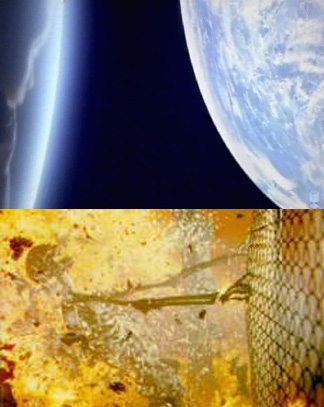
The Technology of Art and the Art of Technology
Except for oral storytelling and oral poetry, all the arts depend on some kind of technology. You have to intuit a lot about physics to make even the simplest musical instrument. There is no painting without the chemistry of paint. Theatre requires that you build a stage and make costumes or masks.
But generally, we donít think of these simple crafts as technology. Now, we reserve that word for the electrical, mechanical, and chemical systems that were invented in the 19th century (and for their 20th-century electronic descendants). The technologies of the older arts have matured, certainly. Acrylics supersede oil paints; electric guitars join their acoustic ancestors; electric light succeeds limelight in the theatre. But the basic techniques have remained the same.
 |
||
| Kubrick's 2001: A Space Odyssey set the bar for special effects with its inventive use of analog technology. | ||
Film, however, has ridden a technological roller coaster for the past hundred years. No other art is so dependent on modern technology. So, to understand how film talks to us, we need to spend some considerable time investigating that technology. Kubrickís 2001: A Space Odyssey is a central film here. Although it was made a generation ago, it set the tone for the use of (and advancements in) film technology that still pertains today.
For the first 30 or 40 years, the technologies of recording sound and recording images developed separately. It wasnít that they didnít want to marry; they hadnít found a way. In the late 1920s, that union was finally consummated when the first talking movies appeared and the first broadcast television system was demonstrated. From that point on, sound and image were conjoined. Sometimes the relationship has been stormy, but the medium we are talking about combines both these senses. Action-adventure films might survive without sound (even though the explosions and gunfights would have significantly less impact), but would you want to watch a silent Singiní in the Rain?
So now we are dealing with a spectrum of recording art, from music without video to TV sitcoms with laugh tracks; from seven-channel-surround-sound blockbuster movies to IMAX experiences; from 6,000 MP3 songs stored on your iPod to constantly saved 10-hour blocks of video on your TiVo.
Film is enormously―and increasingly―technological. Gazillions of man-hours (to use the Internet term) have gone into developing this technology during the last hundred years and more. The digital revolution has increased the technology quotient a thousand-fold. Kubrickís 2001 set the tone for a generation, but James Cameronís Terminator 2: Judgment Day (1991), 23 years later, upped the ante with its use of digital effects.
At the same time, conversely, there is a good bit of esthetic pleasure in the technology itself—the technical systems people have come up with to record and display images and sounds are remarkably ingenious. Weíll spend some time appreciating that genius during this course. Youíll find that the basic technical precepts are a lot less daunting than you might imagine―and, hopefully, even enjoyable!
Many of the devices designed to capture images and sounds―and display them―have found their way into museums as art objects themselves. Collectors trade old Bolex cameras, Moviola editing machines, and Cinématographe cameras/projectors not only because they are beautifully designed but also because of the creative thinking that went into their engineering. Wealthy audiophiles and videophiles often spend tens of thousands of dollars on their gear not only to get the best sound and image, but also because that gear is cool to look at and talk about. Indeed, as movies and music have moved from remote theaters into our living rooms, the medium has provided industrial designers their greatest platform to show off their skills. Indeed, "gearheads" are mavens of the art of design!
The point? To know how to read a film you have to know something about this huge technological base. The study of that technology will take up a good bit of our time here. Weíll begin with it in Lesson 2, "The Technology of Filmmaking."